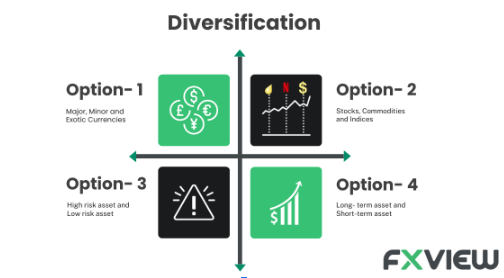
Understanding Diversification
Are you new to the world of diversification in Forex trading? If so, then think of it like managing a basket of different fruits. Would you rather spend all your money on one type of fruit to fill the basket or enjoy a variety of different fruits? Similarly, diversification in forex means spreading your investments across different currency pairs instead of just one.
In this guide, we’re going to talk about why diversification matters and how it can help you manage risks and improve your benefits in forex trading. So, grab a seat and let’s explore the world of diversification together!
Understanding Diversification
Diversification is a forex trading strategy that involves spreading investments across different currency pairs, rather than concentrating all your funds in one currency or trade.
How to Diversify?
Here are the many ways to diversify a portfolio:
- Select Multiple Currency Pairs: Instead of focusing on just one currency pair, you could spread your investments across several pairs. This could include major pairs like EUR/USD, GBP/USD, USD/JPY, and AUD/USD, as well as minor and exotic pairs. Each pair has its own characteristics and factors influencing its movements, so diversifying across them may help spread risk.
- Understand Correlations: Some currency pairs have strong correlations, meaning they tend to move in the same direction. For example, EUR/USD and GBP/USD often move together. An effective way to diversify is to choose pairs that have low or negative correlations with each other. This ensures that a portfolio isn’t overly exposed to one economic factor.
- Mix Fundamental and Technical Analysis: Incorporating a mix of fundamental and technical analysis into a trading strategy. Fundamental analysis involves evaluating economic indicators, central bank policies, geopolitical events, and news releases that impact currency values. Technical analysis focuses on price charts, patterns, and indicators to identify trends and entry/exit points. By combining both approaches, one could diversify their trading strategies and potentially increase potential benefits.
- Use Different Timeframes: Trading across different timeframes to diversify a trading approach. For example, you may have long-term trades based on monthly or weekly charts for major trends, while also executing short-term trades based on intraday or hourly charts for quick profits. Diversifying timeframes can help capture various market opportunities and may reduce the impact of short-term volatility.
- Employ Hedging Strategies: One could consider using hedging strategies to mitigate risk. Hedging involves opening positions in opposite directions on correlated currency pairs to offset potential losses. While hedging doesn’t eliminate risk entirely, it can provide a degree of protection during volatile market conditions.
- Allocate Capital Wisely: Allocating trading capital across different currency pairs based on their volatility, liquidity, and your risk tolerance. This could help avoid overexposing oneself to one particular currency or trade. Proper capital allocation might ensure that one could withstand losses in some positions while still having the ability to capitalise on profitable opportunities in others.
- Monitor and Re-balance: Regularly monitoring a portfolio and adjusting positions as needed could have its benefits as well. As market conditions change over time and what works today may not work tomorrow. Re-balancing a portfolio could ensure that you’re always diversified and possibly adapting to changing market dynamics.

Benefits of Diversification
Here are the many reasons why diversification could be beneficial:
- Risk Management: Risk is quite inevitable when it comes to forex trading. Currencies can be highly volatile, influenced by various economic, political, and geopolitical factors. By diversifying your investments across multiple currency pairs, you manage your risk. If one currency pair performs poorly, losses from that pair may be offset by gains in others.
- Reducing Volatility: Different currency pairs exhibit different levels of volatility. Some pairs are more stable, while others are more volatile. By diversifying across pairs with varying volatility levels, you can smooth out the overall volatility of your portfolio. This can lead to more consistent returns over time.
- Capital Preservation: Concentrating all your funds in one currency pair can be risky, especially if that pair experiences a sudden and significant movement against your position. Diversification helps protect your capital by ensuring that a single adverse event doesn’t wipe out your entire account.
- Exploiting Opportunities: Different currency pairs are influenced by different factors. By diversifying, you increase your exposure to various market conditions and opportunities. For example, if you believe that the US dollar will strengthen against the Euro but weaken against the Japanese Yen, you can take positions in both EUR/USD and USD/JPY to capitalise on these views.
- Correlation Management: Some currency pairs exhibit strong correlations with each other, meaning they tend to move in the same direction. Diversification allows you to manage correlation risk by choosing pairs that are less correlated. This ensures that your portfolio isn’t overly exposed to a single economic factor or event.
- Flexibility and Adaptability: Markets are constantly evolving, and what works today may not work tomorrow. Diversification provides flexibility and adaptability to changing market conditions. If one trading strategy or currency pair stops performing well, you can adjust your portfolio accordingly without risking everything on a single bet.
Key Takeaways
- Diversification is a strategy that involves spreading investments across various currency pairs.
- Diversification can be done by, selecting multiple types of currency pairs, allocating capital wisely and understanding correlations.
- Diversification could have benefits such as risk management, reduced volatility, capital preservation and flexibility.
Conclusion
Diversification can be quite a useful trading strategy if utilised effectively. While it does not guarantee profits, it can help build a resilient and balanced trading strategy. As it allows traders to manage risks and reduce volatility.
Disclaimer: The information in this article is provided for educational and informational purposes only and is not intended to be, nor does it constitute financial, investment, or trading advice. You should not make any financial, investment, or trading decisions based on the information provided in this article without performing your research or seeking advice from an independent advisor.



